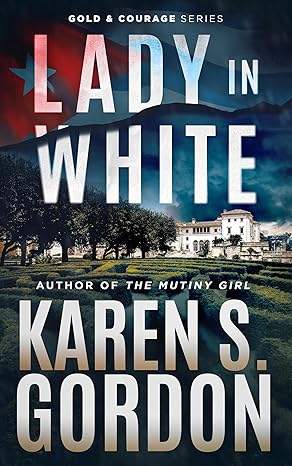The Bottom Line: Drawing upon real-world figures, Lady in White is a gripping and believable tale of ransom, rebellion and political intrigue.

There’s no such thing as a normal day at the office for money laundering duo Lauren Gold and Vance Courage. Their latest adventure begins as Vance drops Lauren off at Miami International Airport, where she’s set to fly to the Caymans to check out their next business opportunity. But their plan is turned upside down just two short hours later, when Vance answers a call from Lauren’s phone – only to find out that his partner and girlfriend has been kidnapped.
The caller threatens to kill Lauren unless Vance meets them at the Vizcaya Museum and Botanical Gardens, a historic 1916 waterfront estate located in South Miami. What should be an easy meeting to determine ransom conditions is anything but. A stranger sabotages one of Vance’s tires, and a surly photographer adds to Vance’s already crazy day. Topping it off, the kidnappers’ demands don’t make any sense.
Vance is told that Lauren will die unless he returns what he allegedly stole from a purported real-world James Bond named Ricardo ‘Monkey’ Morales. But Vance is pretty sure that Morales – a legendary Cuban exile and accused gunrunner and assassin alleged to have worked for the CIA, FBI and DEA – died years ago. Also, there’s this gem: Morales supposedly needs the money because he’s about to overthrow the Cuban government.
Karen S. Gordon’s latest Gold and Courage caper deftly draws inspiration not only from Morales, whose real-life persona is the stuff of legend, but also from Ladies in White, an actual government opposition movement founded by wives and female relatives of jailed dissidents — journalists, scientists and others who criticized the Castro government. Gordon’s plot is a complete original, but the integration of real-world players and their motivations enrich what is already a compelling story. Readers will be Googling juicy details about both Morales and the Ladies in White as they encounter them throughout the book.
Readers looking for escapist fare will find themselves transported to the islands (“Rows of navy-blue umbrellas and lounge chairs evenly spaced on the pearly sand”) as well as some enviable properties (The driveway led to a sprawling colonial-style estate with white columns barely visible in the torrential rain.) Gordon’s gift for vivid imagery has never been better or more nuanced, as she delivers powerful juxtapositions of breathtaking beauty with the sobering effects of human impact (“plastic bottles bobbed in the shallow water lapping against the seawall”).
In a formula Gordon has now perfected in the series, the book’s second half is heavier on legal intrigue. Information on the implications of offshore banking, tax havens and legal frameworks regulating financial transactions across jurisdictions is fascinating. Passages touching on immigration law, civil litigation and tax fraud and evasion are written with a depth only someone of Gordon’s experience could deliver.

